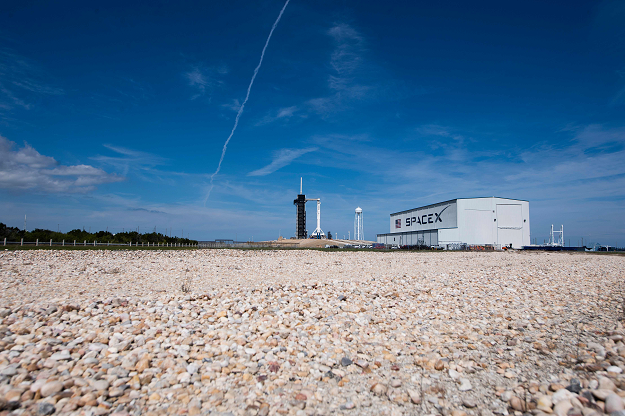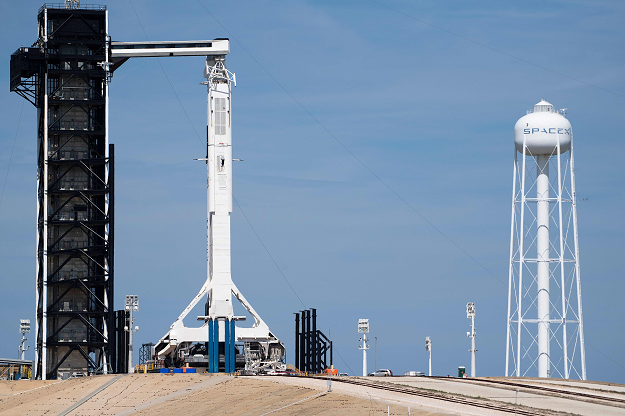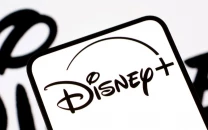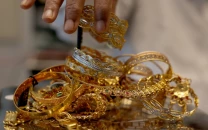SpaceX launches rocket carrying new Dragon capsule
The capsule separated from the Falcon 9 SpaceX rocket as planned after take off

The rocket blasted off without incident at 2:49 am from the Kennedy Space Center at Cape Canaveral, lighting up Florida's coastline.
Eleven minutes later, the confirmation came from SpaceX mission control: "Dragon separation confirmed."
That triggered cheers at the firm's headquarters and at the Kennedy Space Center.
The capsule is scheduled to reach the ISS by Sunday at around 1100 GMT, with a return to Earth next Friday.
It will splash down in the Atlantic Ocean, from where it will be brought back to Cape Canaveral.
In another success, the rocket's first stage returned to Earth, landing on a platform 500 kilometers off the Florida coast in the Atlantic. It marks the 35th such recovery by SpaceX.
After its shuttle program was shuttered in July 2011 after a 30-year run, NASA's manned flights came to an end.
Since then, it has been buying seats in Russian Soyuz rockets -- the only ones capable of transporting humans there.
Keeping its options open, the US space agency in 2014 awarded contracts to both SpaceX and Boeing for them to take over this task.
Boeing's Starliner capsule will be tested in April, at the earliest.
Liftoff! pic.twitter.com/RUtN1QBS08
— SpaceX (@SpaceX) March 2, 2019
The excitement was palpable Friday at Cape Canaveral, where a day earlier the rocket was wheeled out of its hangar and staged in a vertical position on the legendary launch pad where the Apollo Moon missions took off.
LIFTOFF! The next big leap in a new chapter of U.S. human spaceflight systems has left the pad. @SpaceX’s #CrewDragon demo flight will be the 1st commercially-built & operated American spacecraft designed for humans to dock at the @Space_Station. Watch: https://t.co/Fm5NQSfAXJ pic.twitter.com/YoiOf67kQL
— NASA (@NASA) March 2, 2019
"It's been a long eight years," said Bob Cabana, the Kennedy Space Center's director and a former astronaut.
"It's exciting to see a crewed vehicle, the SpaceX Dragon, up there on a Falcon 9 on pad 39A," said Cabana, who witnessed the last space shuttle flight return to Cape Canaveral on July 21, 2011.
NASA greenlights SpaceX crew capsule test to ISS
After the shuttle program was shuttered in 2011 after a 30-year run, NASA began outsourcing the logistics of its space missions.
It pays Russia to get its people up to the orbiting research facility at a cost of $82 million a head, for a round trip.
In 2014, the US space agency awarded contracts to SpaceX and Boeing for them to take over this task.
#UPDATE @SpaceX's new Crew Dragon capsule successfully launches and is en route to @Space_Station with a dummy astronaut on board named Ripley https://t.co/tfpnUd3Gba pic.twitter.com/Omv52Znpul
— AFP News Agency (@AFP) March 2, 2019
But the program has suffered delays as safety requirements are much more stringent for manned flights than for unmanned missions to deploy satellites.
The sky over the launch site was clear Friday, with meteorologists saying there was an 80 per cent chance of conditions being favorable overnight.
SpaceX blasts off powerful GPS satellite for US military
"When you're here, right, there's a pride in the country. It's different," said Mark Geyer, director of the Johnson Space Center, where US astronauts are based. "There's a pride in what the United States and its teams can accomplish."
Boeing also received a contract in 2014 to develop a space vessel, the Starliner. It will not be tested until April, in a mission similar to SpaceX's.
NASA did not want to rely on just one single vehicle, in case of accidents.
 PHOTO: AFP
PHOTO: AFPPlanning has been delayed by around three years, with the first manned SpaceX flight still penciled in for July, though officials frequently refer to the end of 2019 as a more realistic deadline.
Saturday's flight aims to test the vessel's reliability and safety in real-life conditions.
The dummy that will ride in the capsule -- which SpaceX's Hans Koenigsmann prefers to call a 'smartie' -- has been nicknamed Ripley in honor of the character played by Sigourney Weaver in the 'Alien' movies.
It will be fitted with monitors to test the forces that future astronauts will be subjected to on take-off and when they return to the Earth's atmosphere and then splash down in the Atlantic, slowed down by giant parachutes.
 The SpaceX Falcon 9 rocket with the unmanned Crew Dragon capsule on its nose sits at Kennedy Space Center. PHOTO: AFP
The SpaceX Falcon 9 rocket with the unmanned Crew Dragon capsule on its nose sits at Kennedy Space Center. PHOTO: AFPEverything will have to function according to a strict plan: the separation of the capsule and the rocket, the 27 hours orbiting towards the space station and then docking with it.
"We instrumented the crap out of that vehicle," said Kathy Lueders, the manager of NASA's Commercial Crew program. "We're going to learn a ton from this mission."
For SpaceX, which Musk founded in 2002, sending an astronaut into orbit would be a culmination of years of hard work and high-risk investment.
"Every mission is important, but this is even more important, said Koenigsmann, the firm's vice-president for build and flight reliability.
"Early on, our goal was human spaceflight," he said. "Human spaceflight is a core value of business of SpaceX."
 PHOTO: AFP
PHOTO: AFPIn less than a decade, SpaceX has become a key partner for NASA, in addition to dominating the market for private satellite launches.
Its Falcon 9 rockets have resupplied the space station 15 times in seven years, even though one of them blew up in 2015.



















COMMENTS
Comments are moderated and generally will be posted if they are on-topic and not abusive.
For more information, please see our Comments FAQ